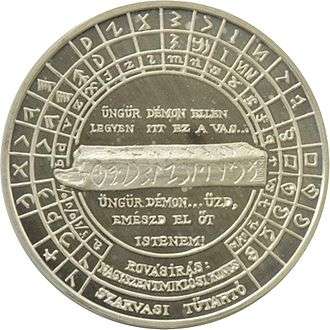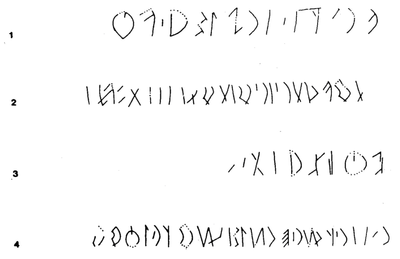Szarvas inscription
The Szarvas inscription refers to the inscription on a bone needle case found near Szarvas in southeastern Hungary and dating from the second half of the 8th century, the "Late Avar" period (700-791).[1]
The needle case and its inscription

The name of the script of the Szarvas inscription

The Hungarian archeologist, historian and linguist Gábor Vékony named the script used on the needle case as "Kárpát-medencei rovásírás" ("Carpathian Basin Rovas script").[4][5] He often used this term in his book, A székely írás emlékei, kapcsolatai, története, e.g. in the chapter "A kárpát-medencei rovásábécé korabeli feljegyzése" ("The contemporary record of the Carpathian Basin Rovas alphabet").
Vékony analysed the similarities and the differences between the Old Hungarian and the Carpathian Basin scripts on page 154 of his book.[6] On page 232, Vékony wrote: "- Aethicus Ister jelei azonosak az egykori Kárpát-medencei rovásírás jeleivel." ("The symbols of Aethicus Ister are identical to the symbols of the quondam Carpathian Basin script").[7]
Vékony also writes : "E jel a Szarvason azonosított Kárpát-medencei f alig torzult megfelelője..." ("This symbol is identical to the Carpathian Basin 'f' identified in Szarvas". (referring to the bone needle case found in Szarvas)[8]
In page 233, Vékony writes: "Erre utalhat az is, hogy ez a betűalak levezethető egy párthus alep formából. Feltehető tehát ennek a jelnek a megléte a Kárpát-medencei rovásírásban is (a székelybe is innen származhatott)." ("This could imply also that this glyph can be derived from the Parthian Aleph form. Consequently, the existence of this symbol can be supposed in the Carpathian Basin script as well (it could originate from this to the Székely)."[9] Here the 'Szekely' refers to the Szekely-Hungarian Rovas script also known as Old Hungarian script. Vékony's writing suggests a proposal that a Carpathian Basin Rovas script may be one of the ancestors of the Szekely-Hungarian Rovas script.
The meaning of the inscription
Gábor Vékony's transcription[10] was improved by linguist Erzsébet Zelliger. The last character of the fourth row of the inscription was reconstructed by Vékony. The edges of the bone needle case are worn, and the top and bottom edges for part of the characters are not clearly visible.[11]
Transcription with IPA notation
The following transcription using the International Phonetic Alphabet is based on Vékony's original transcription.[12] Superscript segments and those in brackets are reconstructed.
| No. of row | Transcription (using IPA) | Translating from Ancient Hungarian |
|---|---|---|
| 1st | /ynɡyr isnɛk im iʎ βaʃu/ | |
| 2nd | /[t]iɣ teβɛdɣen isen tiɣ tiɣ sur bek βorɣ/ | |
| 3rd | /fɛʃɛs ɛlei sɜl [...]/ | |
| 4th | /ynɡyr ne adɣon [ɜzdɣ] imesd eɣt ɛn iʃtɛnɛ[m]/ |
In the inscription, the third symbol of the third row (from left) could be considered a descendant of the ideograms in Turkic languages. However, their possible relationship needs further evidence.
Transcription with Hungarian phonetic notation
| No. of row | Transcription (using Hungarian phonetic notation) | Translating from Ancient Hungarian (modern meaning) |
|---|---|---|
| 1st | /üngür : isznek im ily : βasu/ | Here is an iron [needle] against demon Üngür; |
| 2nd | /[t]iɣ tëβedγën : iszën : tiɣ tiɣ szur bëk βorɣ/ | [Needle should be pricked into the demon; needle, needle, stab, poke, sew-[in]! |
| 3rd | /fesesz : elëi szɜl [...]/ | [Who] unstitches […]; |
| 4th | /üngür në : adɣon : [ɜzdɣ] imëszd ëɣt en : istene[m]/ | Üngür shall not give [curse]; […], blast him, my God!’' |
Critics and alternative theories
Vékony had read the Szarvas transcription as Hungarian, thus proposing it as evidence that the Hungarian-speaking people had appeared in the region by the 7th century. There are several critics of Vékony's theories and translations, most notably the Hungarian linguist and historian, András Róna-Tas. The debates were summarized by István Riba in 1999 and 2000: "many find themselves unable to accept Vékony's theory".[13][14]
The key point of the critics has been that in traditional Hungarian scholarship, the existence of the Hungarian-speaking population dates from 896 (when the Magyars took over the Carpathian Basin ), while the Szarvas needle case dates from the 8th century. Consequently, either the Szarvas inscription is not in Hungarian or Hungarians were in the Carpathian Basin much earlier than the late 9th century. Róna-Tas attempted to read the Szarvas relic in Turkic instead of Hungarian, but wrote that his transcription needed further improvement.[15] The issue remains an open question amongst Hungarian scholars.
See also
- The Alsószentmihály inscription on a building stone found in Mihai Viteazu, Cluj (Transylvania, today Romania).
Notes
- ↑ Róna-Tas, András (1996): A honfoglaló magyar nép [The landtaking Hungarian nation]. Bevezetés a korai Magyar történelem ismeretébe [Introduction to the knowledge of the early Hungarian history]. Budapest: Balassi Kiadó, ISBN 963-506-106-4
- ↑ Vékony, Gábor (1987): Spätvölkerwanderungszeitliche Kerbinschriften im Karpatenbecken. Acta Acheologica Hungarica Vol. 39, pp. 211-256.
- ↑ Vékony Gábor (2004): A székely írás emlékei, kapcsolatai, története. Budapest: Nap Kiadó
- ↑ Vékony Gábor (2004): A székely írás emlékei, kapcsolatai, története. Budapest: Nap Kiadó. ISBN 963-9402-45-1, page 203, first line of the second paragraph
- ↑ G. Hosszú: Proposal for encoding the Carpathian Basin Rovas script in the SMP of the UCS. National Body Contribution for consideration by UTC and ISO/IEC JTC1/SC2/WG2, January 21, 2011, revised: May 19, 2011, Universal Multiple-Octet Coded Character Set. ISO/IEC JTC1/SC2/WG2 N4006
- ↑ Vékony Gábor (2004): A székely írás emlékei, kapcsolatai, története. Budapest: Nap Kiadó. ISBN 963-9402-45-1, page 154, first row of the second paragraph
- ↑ Vékony Gábor (2004): A székely írás emlékei, kapcsolatai, története. Budapest: Nap Kiadó. ISBN 963-9402-45-1, page 232, eighth and ninth rows of the second paragraph
- ↑ Vékony Gábor (2004): A székely írás emlékei, kapcsolatai, története. Budapest: Nap Kiadó. ISBN 963-9402-45-1, page 235, second and third rows of the second paragraph
- ↑ Vékony Gábor (2004): A székely írás emlékei, kapcsolatai, története. Budapest: Nap Kiadó. ISBN 963-9402-45-1, page 233, last six rows in the first paragraph
- ↑ Vékony, Gábor (1987): Későnépvándorláskori rovásfeliratok a Kárpát-medencében [Rovas inscriptions from the Late Migration Period in the Carpathian Basin]. Szombathely-Budapest
- ↑ Vékony, Gábor (1987): Későnépvándorláskori rovásfeliratok a Kárpát-medencében [Runic inscriptions from the Late Migration Period in the Carpathian Basin]. Szombathely-Budapest: Életünk szerkesztősége
- ↑ Vékony Gábor (2004): A székely írás emlékei, kapcsolatai, története. Budapest: Nap Kiadó
- ↑ Riba,István: Jöttek, honfoglaltak, fújtak. Régészvita egy rovásírásról [Came, settled, blown. Archaeological debate about the runic writing]. In: Heti Világgazdaság [Weekly Word's Economy], Vol. 21. 1999. N. 46. pp. 101-102, 105.
- ↑ Riba, István (2000). "Reading the Runes: Evidence of the Dual Conquest?". The Hungarian Quarterly. Vol. XLI. No. 157, Spring 2000
- ↑ Róna-Tas, András (1996): A honfoglaló magyar nép [The landtaking Hungarian nation]. Bevezetés a korai Magyar történelem ismeretébe [Introduction to the knowledge of the early Hungarian history]. Budapest: Balassi Kiadó, pp. 108-110
References
- Juhász, Irén (1983): Ein Avarenzeitlicher Nadelbehälter mit Kerbschrift aus Szarvas. In: Acta Acheologica 35 (1983), p. 34
- Juhász, Irén (1985): A szarvasi avar rovásírásos tűtartó [The Avar need-case of Szarvas with Rovas script]. Magyar Tudomány [Journal of the Hungarian Science], 85:2, pp. 92–95 (Hungarian)
- Kristó, Gyula & Makk, Ferenc (2001): A kilencedik és a tizedik század története [The history of the 9th and the 10th centuries]. In: Magyar Századok [Hungarian Centuries]. Published by Pannonica Kiadó, Ser. ed.: Gyula Szvák, 222 p. ISBN 963-9252-38-7 (Hungarian)
- Riba,István: Jöttek, honfoglaltak, fújtak. Régészvita egy rovásírásról [Came, settled, blown. Archaeological debate about the runic writing]. In: Heti Világgazdaság [Weekly Word's Economy], Vol. 21. 1999. N. 46. pp. 101–102, 105; ISSN 1217-9647 (Hungarian)
- Róna-Tas, András (1999). Hungarians and Europe in the early Middle Ages: An introduction to early Hungarian history. Central European University Press. ISBN 963-9116-48-3
- Róna-Tas, András (1996). "The Migration and Landtaking of the Magyars", The Hungarian Quarterly. Vol. XXXVII, No. 144, Winter 1996, pp. 37–41
- Vékony, Gábor (1985): Késő népvándorláskori rovásfeliratok [Runic inscriptions from the Late Migration Period]. In: Életünk Vol. XXII, No. 1, pp. 71–84 (Hungarian)
- Vékony, Gábor (1987): Későnépvándorláskori rovásfeliratok a Kárpát-medencében [Runic inscriptions from the Late Migration Period in the Carpathian Basin]. Szombathely-Budapest: Életünk szerkesztősége. ISBN 978-963-02-5132-7 (Hungarian)
- Vékony Gábor (2004): A székely írás emlékei, kapcsolatai, története. Budapest: Nap Kiadó. ISBN 963-9402-45-1 (Hungarian)
Further reading
- Gábor Hosszú (2011): Heritage of Scribes. The Relation of Rovas Scripts to Eurasian Writing Systems. First edition. Budapest: Rovas Foundation, ISBN 978-963-88437-4-6
External links
- The Szarvas Rovas inscription on the RovasPedia
- Jenő Demeczky, Dr. Gábor Hosszú, Tamás Rumi, László Sípos, Dr. Erzsébet Zelliger: Revised proposal for encoding the Rovas in the UCS. Individual Contribution for consideration by UTC and ISO/IEC JTC1/SC2/WG2, 14. October 2012.
- Rovás Info News Portal
- Rovas Foundation: Code request for the Rovas script in ISO 15924 (2012-10-20)
- Jenő Demeczky, György Giczi, Dr. Gábor Hosszú, Gergely Kliha, Dr. Borbála Obrusánszky, Tamás Rumi, László Sípos, Dr. Erzsébet Zelliger: Additional information about the name of the Rovas script. Individual Contribution for consideration by UTC and ISO/IEC JTC1/SC2/WG2, 2012-10-21.
- Jenő Demeczky, György Giczi, Gábor Hosszú, Gergely Kliha, Borbála Obrusánszky, Tamás Rumi, László Sípos, Erzsébet Zelliger: About the consensus of the Rovas encoding - Response to N4373 (Resolutions of the 8th Hungarian World Congress on the encoding of Old Hungarian). Individual Contribution for consideration by UTC and ISO/IEC JTC1/SC2/WG2. Registered by UTC (L2/12-337), 2012-10-24
